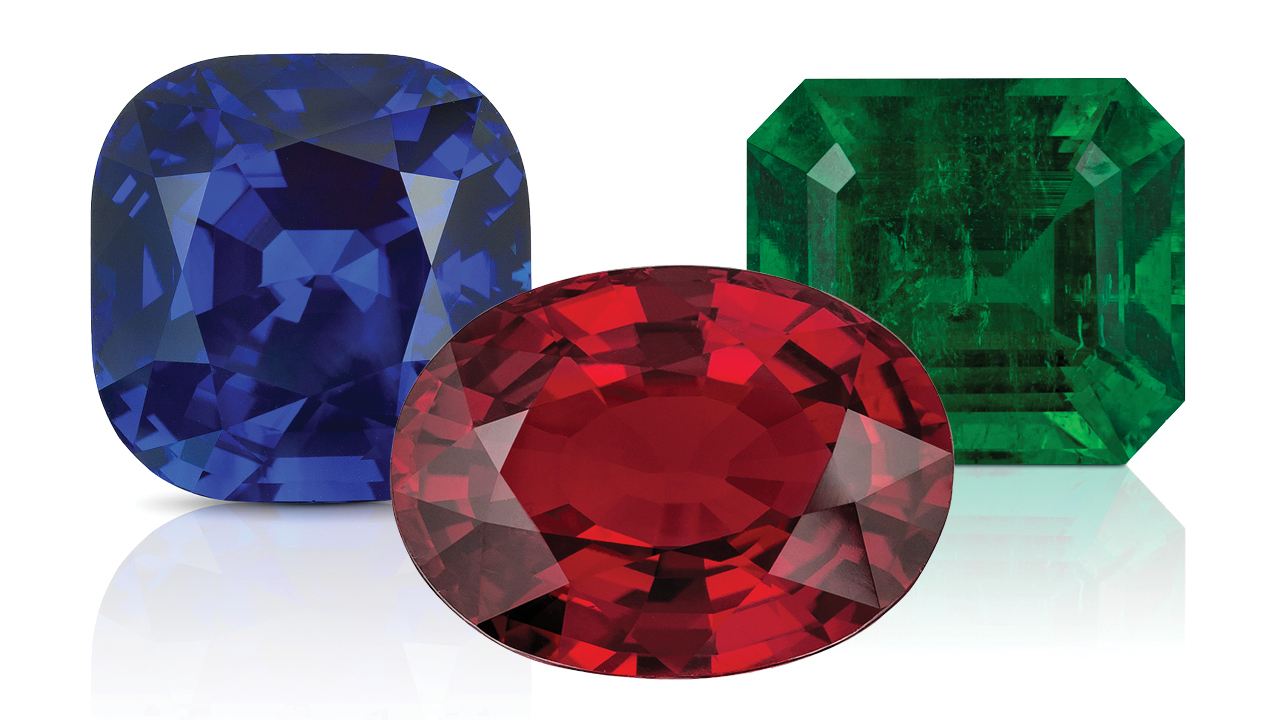Afshin Hackman is used to incremental price increases on the rubies and sapphires he seeks out on buying trips to Thailand. These jumps are usually 5% to 10% — but not 40% in 10 months.
As of press time, the principal at gem wholesaler Intercolor had just returned from a trip after last visiting in early 2023; it was a frustrating and expensive ordeal. “I spent two weeks there and bought from 18 different companies,” he says. “In fine qualities, the merchandise was outrageously overpriced.”
Cultured-pearl sales aren’t any better. Demand in China has driven up costs to shocking levels; wholesale prices at the 2023 Jewellery & Gem World Hong Kong show, which took place from September 18 to 24, were retail prices for US dealers.
“The growing demand of the Chinese market buying all the pearls at inflated prices leaves the rest of the world with very little inventory,” says Ankeet Shah, director of supplier Continental Pearl.
The overall message from jewelers? The materials are as beautiful as ever, and demand is at an all-time high, but prepare to pay more for most colored gems and pearls.
Here’s a breakdown of the burning issues and trends in today’s market.
Sourcing struggles
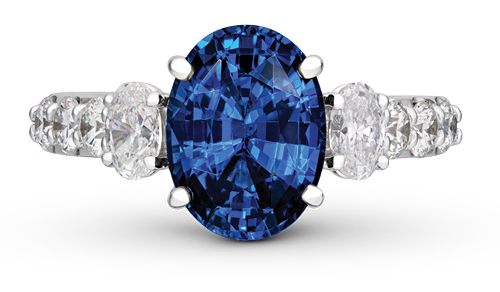
Gemstone and cultured-pearl sales are strong, but pearl demand from China and the difficulty of sourcing unheated gems are pushing prices up to previously unseen levels. Purveyors of commercial-quality — aka heated — stones have no problem securing affordable and abundant merchandise, but that’s not the case for peers at the high end of the market. Untreated gems are harder to find and super costly.
This stems in part from the Covid-19 era. Mine closures worldwide and restricted travel for gem-buyers led to supply-chain disruptions. Sellers in source countries started reaching out via WhatsApp to dealers in the US and elsewhere, but unknown outside dealers would dig into those US wholesalers’ followers to suss out and steal away their customers.
Meanwhile, increased global demand for gems has created more competition for stateside sellers. There are now more buyers and a lack of quality goods, according to Sailesh Lakhi, CEO of gem supplier Sparkles and Colors.
Not surprisingly, these events put pressure on prices. “Not even 1% of production is unheated,” says Hackman. “[The price of] untreated ruby has doubled in the past two years, compared to double or triple prices [for] unheated blue sapphires. And with crashing diamond prices, a lot of diamond dealers are even getting into color.”
Jaimeen Shah knows the sourcing struggles firsthand. Over the last four months, the partner in wholesaler Prima Gems USA has only been able to find about one top-tier stone a month. But by the time he’s ready to buy, “someone else has jumped my offer by an unimaginably high sum,” he says. “People are buying today at prices we should be selling for in five years.”
Lakhi has similar issues: “Five years ago, we would receive 10 no-heat stones in a week. Then it slowed to five to seven in a week, and now it’s one a month.”
Prices: The ups and downs
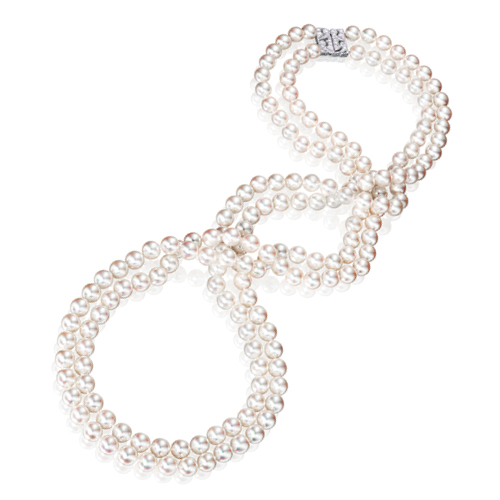
Eric Yen, director of Yen’s Jewelry & Accessories, knows where to find the merchandise he needs, but getting it at the right price is a whole other mountain to climb.
Prior to the pandemic, Chinese farmers would sell their freshwater pearls by the kilo to firms in Hong Kong, which would outsource the sales from there.
Now, Chinese social media influencers and YouTubers are “buying individual pieces in bulk” and selling them directly to mainland customers via their channels, Yen reports. This makes it impossible for traditional wholesalers to make strands and obtain merchandise at prices US consumers are used to paying. “If US sellers aren’t following these trends and not keeping up with price increases, most of the mom-and-pop shops will be priced out,” he warns.
Pearl farming issues around the globe — including diminished production — also figure in pricing woes. “Production is down by half, and demand globally is very strong — maybe more than double in the last few years, with many new markets wanting pearls,” says Continental’s Shah. “For the US market, the most difficult type of pearls to obtain are the top, nice-quality ones in all varieties, as the Chinese market is buying everything at very high prices.”
While there’s no end in sight to pearl problems, gem wholesalers may, ironically, get a price reprieve thanks to fewer fourth-quarter sales in the US. Retail jewelry sales declined 2% year on year between November 1 and December 24, according to data from Mastercard SpendingPulse, and less demand typically leads to lower prices. “We just noticed a better supply of blue sapphires for acquisition because the market is soft,” relates Lakhi.
Meanwhile, two international wars — in Ukraine and Israel — are sapping energy from buyers. “It’s obvious when you hear what’s going on in Israel. Who wants to buy a gift when families are affected?”
says Lakhi.
Entering an election year further tightens spending. “Every four years, business softens because of the uncertainty of who will win,” says Hackman.
Vibrant jewels that tell a story
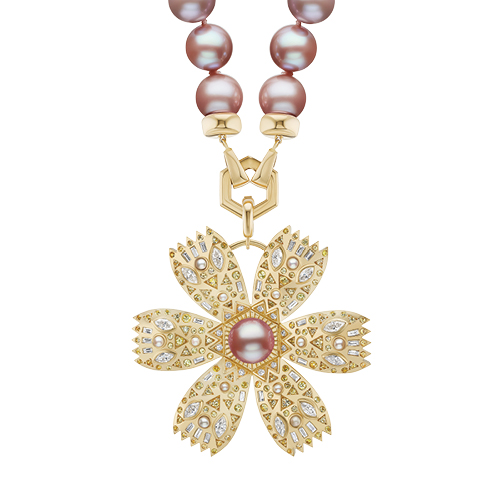
(Harwell Godfrey)
High costs of raw materials aside, collectors still eagerly await new jewels that combine Mother Nature’s bounty with design trends and makers’ innovations. For example, pink, orange and purple gems are strong sellers, as are blue and green ones — including emeralds — and critter motifs.
Padparadscha sapphires remain in vogue, dealers say, thanks to the most recent Pantone Colors of the Year: Viva Magenta in 2023, and Peach Fuzz for 2024. “Pads are popular all year long,” says Lakhi of the pinkish-orange gems.
Yen has been selling intense purple freshwater pearls, but they’re not easy to find. “Only a handful of growers have the right mollusks to put together strands of those,” he reveals.
Plain old pink is another hot color thanks to a certain Mattel doll that had her story anthropomorphized in Hollywood last year. “I do believe pinks are still trending due to the Barbie-core theme,” comments publicist Francesca Simons of the eponymous public relations firm.
Jewelry house Le Vian has collections that touch on many current trends, including the color periwinkle and, in that vein, bluish-purple gems “with varying subtones in pinks and purples,” according to the brand. Another gem it touted last year in its forecast for 2024 was emerald, for those craving “a return to normalcy” and a “restoration of balance.”
Plenty of others agree with that call. Emeralds are strong for Paul Schneider, owner of retailer Twist, which has stores in Portland, Oregon, and Seattle, Washington. Many of Simons’s 12 high-profile jewelry design clients are seeing solid demand for the green gem, which “seems to never go out of style,” she says.
Lakhi, too, keeps seeing green. Zambian material may be the easiest to source, especially in larger quantities. “There’s a worldwide call for emeralds,” he declares. “It’s possible to make a necklace or layout in that origin, but it’s not easy to get in Colombian material.” His favorite emeralds are Ethiopian, with their near-lookalike Colombian color. However, the quantity isn’t there, making suites and larger assortments a challenge: “Mother Nature is not producing that much emerald in Ethiopia.”
Updated pearls are top of mind for Randi Molofsky of For Future Reference, a branding and PR firm for jewelry designers. Some of her top picks have gemstone additions:
“Jade Ruzzo created a fabulous Tahitian strand with prong-set Muzo emeralds in blackened gold, and Harwell Godfrey made two gorgeous strands of pinks and purples that were paired with oversized flower pendants set with pearls and mixed gems,” she relates.
At Twist, men and pearls continue to share a moment — particularly “a plain white strand of pearls,” says Schneider. “Men are wearing them, and they’re very chic right now.”
More demand exists for well-cut color and traceable gems. “People want a unique gem that either has a story about where it was mined or how it was acquired,” adds Prima Gems’ Shah.
Schneider is well acquainted with how important narratives have become. Twist’s niche is designer jewels, so the store features many lines with stories rich in colored gemstones, such as those by Daniela Villegas or Francesca Villa.
He recalls a recent female shopper who got instantly hooked on a particular jewel. She was struggling to overcome a fear of spiders when she strolled into Twist. She didn’t know anything about Villegas, but she felt compelled to purchase a ring by the Mexican-born artist because of its motif — a shocking one considering her arachnophobia.
Featuring champagne-diamond pavé, gold antenna-like pedipalps (the appendages that flank spiders’ mouths), chelicerae (fangs for injecting venom), and four pairs of segmented legs, the arachnid design was “pure drama,” according to Schneider. But the ring “opened a door for her — something she didn’t know she needed until she was looking at it. It was beautiful, precious, and meaningful for her to conquer her fear.”
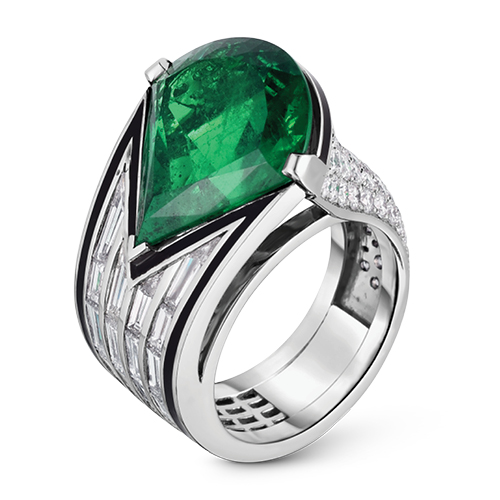
Responsible practices
Ethics and sustainability are an important part of the equation for many of today’s consumers, and gem and jewelry businesses have been working to ensure their goods are traceable and responsibly sourced. One of those businesses is Stuller, which has been a leader in fine jewelry since 1970.
From supplying retailers with loose gemstones and finished jewelry to offering packaging and technology solutions, the Lafayette, Louisiana-based manufacturer and supplier has a hand in nearly every aspect of the business. Guy Borenstein, the firm’s director of gemstone procurement, shares Stuller’s responsible-sourcing and transparency efforts in that field.
What do ethical sourcing and transparency mean to Stuller?
When we say sustainability or responsible sourcing, we’re talking about protecting and restoring the sources and the environment and supporting communities. Stuller wants to make sure that the entire supply chain stays intact.
How does Stuller put this into practice?
In our mine-to-market program, we are tracing stones from their extraction to us. To date, Stuller offers sunstone from Oregon, peridot from Arizona, sapphires from Sri Lanka, and tourmalines and garnets from east Africa through this program.
Stuller demands that its vendors provide documentation and paperwork to be fully transparent, to show that each particular gem came from a certain mine, then went to a cutting factory, to a dealer, and then to us. Every invoice must show the steps through the journey to ensure that nothing unethical happened in the process.
What are the biggest ethical-sourcing challenges the industry is currently facing?
The gemstone market is scattered, and there’s sometimes limited enforcement when it comes to human rights. And even though there are some initiatives to create more responsible mining practices and transparency in the supply chain, they are usually small-scale and don’t affect the world market.
Stuller wants to make sure that miners are treated well, that people on the land in source countries are not being taken advantage of by corporations or warlords, and that they have the right working conditions.
Their human rights must be recognized, and they must get paid for what they’re finding. Organizations and initiatives that Stuller supports give back through infrastructure by way of clean water and through facilities like schools.
We make sure our vendors sign contracts stating that they are completely transparent about where stones came from. Our jewelers ask for this verification. Retail jewelers want to know that what they’re buying is not procured through child labor.
Stuller is a member of organizations that stand for ethics and responsible guidelines, including the American Gem Trade Association (AGTA), the Cultured Pearl Association of America (CPAA), and the International Colored Gemstone Association (ICA). Stuller is also a member of the Responsible Jewellery Council (RJC) and is audited by it, providing a full paper trail so we can show this to our customers.
How can the industry improve the supply chain?
Others simply need to demand documentation from suppliers to show where stones come from—don’t just take their word for it. Check their claims yourself to see if they are correct. By trusting unverified claims, you could be inadvertently making conditions worse.
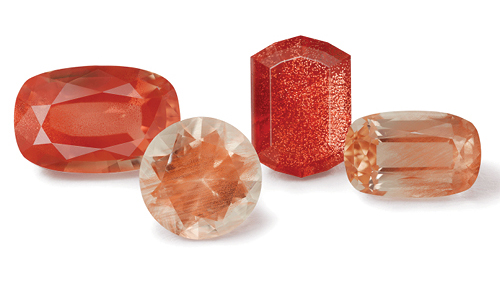
Main image: Blue sapphire, emerald and ruby from Intercolor. (Intercolor)
This article is from the January-February 2024 issue of Rapaport Magazine. View other articles here.
Stay up to date by signing up for our diamond and jewelry industry news and analysis.
